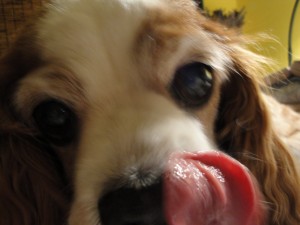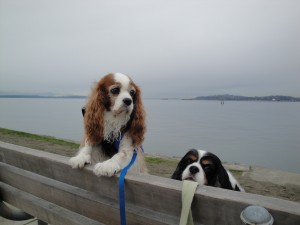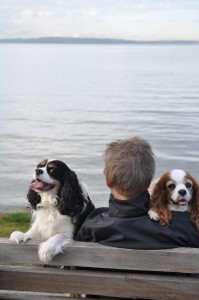 Not every moment in an old, dying dog’s life is grim. Far from it, or neither humans nor animals would, or should, put up with it.
Not every moment in an old, dying dog’s life is grim. Far from it, or neither humans nor animals would, or should, put up with it.
Way back when, Murphy was a puppy. Now, at over 13-1/2, I think about the funny moments. Many of those involve that chew toy, Kong.
I got it so I could stuff it with treats and keep Murphy occupied so I could work. Or at least rest up after participating in her rambunctious puppy (later growing dog, later senior dog) moments.
She had other ideas. She would take the Kong, try to get the treat out, then wise up. Literally.
She’d get up and carry the Kong over to me and stand there, giving me the look.
The first time it happened, I looked at her and said, “You’re supposed to get the treat out by yourself.”
She was having none of it.
I ended up sticking a pen through the short end of the Kong so the cookie would barely peek out of the other end. Murphy would then yank it out, demolish it, and give me that look again as she walked off.
Murphy has always been way too smart for the Kong (and, frankly, usually, me).
For years now we’ve used it as a peanut butter dispensing device. Murphy and, later, Alki each got a Kong in bed at night with a little peanut butter on it.
Just the other night, remembering the old Kong days, I stuck a treat in it for Murphy to toy with, then snapped a picture of her trying to get the treat out. It ended up the same way: with me digging it out for her.
I’ll treasure this photo. It will remind me of her quirky personality, her cut-to-the-chase attitude. She is a wonderful, smart, loving dog.
I think of what a heck of a corporate CEO she’d make: innovative, cunning, easygoing.
 And, as this second photo will prove: satisfied.
And, as this second photo will prove: satisfied.
What else is there?
© 2012 Robyn M Fritz
 We were just sitting on the deck together, and I was reminding Murphy of the very first time we were in that exact same position: back in October 1998, when she’d just come home to live with me. She was 11 weeks old, my introduction to Cavalier King Charles Spaniels.
We were just sitting on the deck together, and I was reminding Murphy of the very first time we were in that exact same position: back in October 1998, when she’d just come home to live with me. She was 11 weeks old, my introduction to Cavalier King Charles Spaniels. It passes, and we wonder, where did it go? As we sat on the deck together in the cooling afternoon sun, I thought of all the things I could be doing: writing another article, cleaning house, updating my website, the things we do to live.
It passes, and we wonder, where did it go? As we sat on the deck together in the cooling afternoon sun, I thought of all the things I could be doing: writing another article, cleaning house, updating my website, the things we do to live. Two days later Murphy was still occasionally coughing, and I wasn’t convinced we were on the right track. But I had work to do. My partner, Fallon, is a Citrine Lemurian Quartz—yes, he’s a crystal ball. We do intuitive consultations privately and at
Two days later Murphy was still occasionally coughing, and I wasn’t convinced we were on the right track. But I had work to do. My partner, Fallon, is a Citrine Lemurian Quartz—yes, he’s a crystal ball. We do intuitive consultations privately and at  Interesting.
Interesting. Do Alki and Grace the Cat care? Does anybody care?
Do Alki and Grace the Cat care? Does anybody care?





















